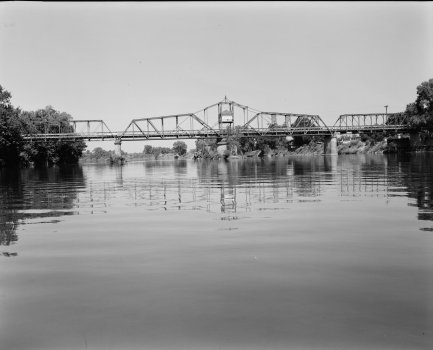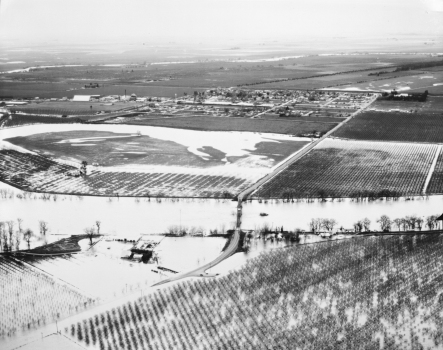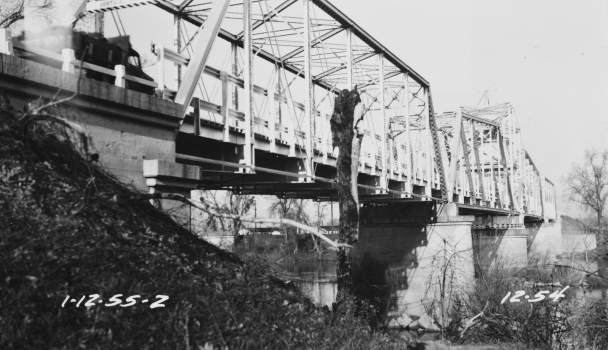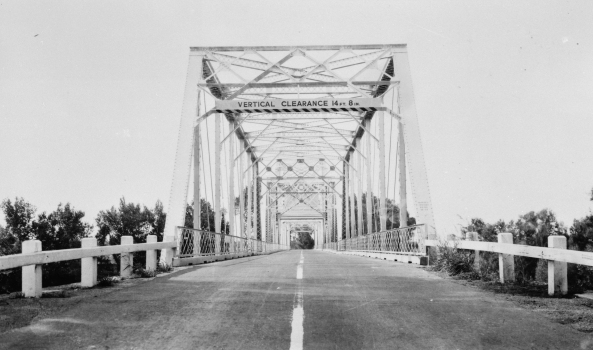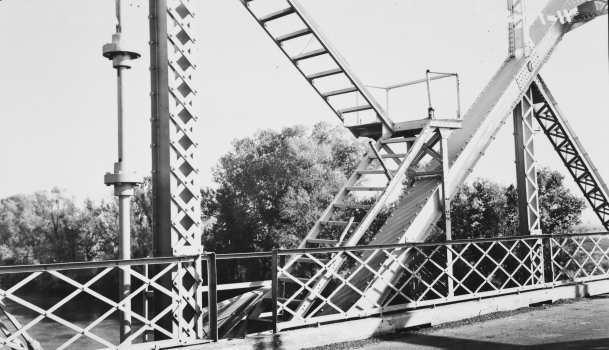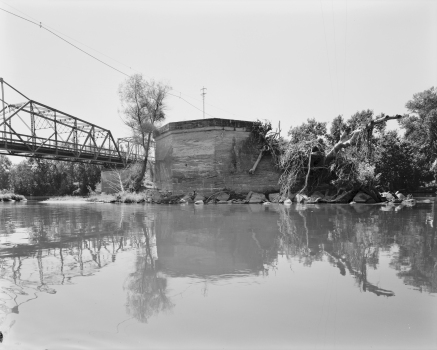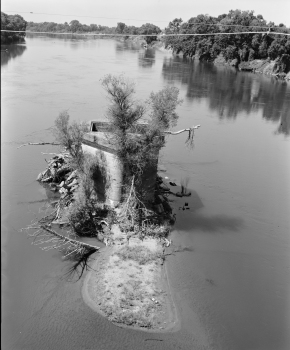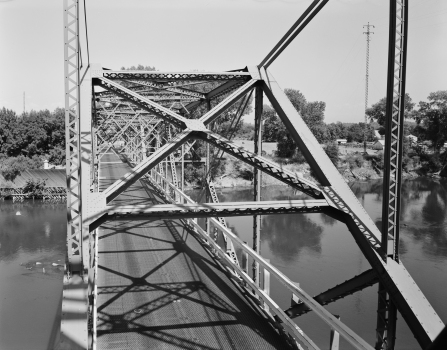General Information
Project Type
| Structure: |
Swing bridge |
|---|---|
| Function / usage: |
Road bridge |
| Material: |
Steel bridge |
| Plan view: |
Structurae Plus/Pro - Subscribe Now! |
| Structure: |
Through truss bridge Pratt type truss bridge Non-parallel chord truss bridge |
| Support conditions: |
for registered users |
| Material: |
Structurae Plus/Pro - Subscribe Now! |
Awards and Distinctions
| 1982 |
for registered users |
|---|
Location
| Location: |
Hamilton City, Glenn County, California, USA |
|---|---|
| Crosses: |
|
| Coordinates: | 39° 45' 3.74" N 121° 59' 47.25" W |
Technical Information
Dimensions
| span lengths | 2 x 40.54 m - 94.79 m | |
| length of movable section | 94.79 m | |
| abutments | number | 2 |
Materials
| piers |
reinforced concrete
|
|---|---|
| truss |
steel
|
| abutments |
reinforced concrete
|
Significance
The Gianella Bridge is the oldest remaining highway swing bridge in California. It is important in local history for its relation to events in local economic and agricultural development. It is the work of John B. Leonard, one of the most important early 20th century bridge engineers. It was listed on the National Register of Historic Places in 1982.
John W. Snyder, Report HAER No. CA-44, Historic American Engineering Record
Description
The Gianella Bridge (also known as the Gianelli Bridge) is composed of two steel through Pratt truss approach spans, each 133 feet in length, and one steel through Pratt truss swing span, 311 feet long. The bridge rests on mass concrete piers and wing abutments. The structure carries two traffic lanes between metal beam guardrails, crossing the Sacramento River with no skew.
As built, the bridge was timber-decked. The original deck was removed in 1937 and was replaced by laminated decking with an asphalt wearing surface. In 1954 the timber stringers and laminated deck were replaced by steel stringers and an open steel grate-type deck. At that time the original lattice steel railings were replaced by the present guardrails to provide increased protection for the truss members. By 1938 the small number of required openings of the bridge led to disconnection of the electrical machinery and provision for manual operation of the swing span, an operation which required eight men to open and close the bridge. In 1972 an agreement was reached with the Coast Guard that the bridge need not be maintained for opening, but that it would have to be restorable to that condition within six months of written notification by the Coast Guard. Accordingly, the bridge has not been opened since that time.
History: The Bridge
In early 1907 (and for some time prior) both Glenn and Butte Counties in Northern California had desired to bridge the Sacramento River but could not reach an agreement on funding or site. (The center of the river marks the boundary between the two counties.) Spurring the desire for a link between the two counties was a current boom in sugar beet farming. Alta California Sugar Beet Company had sited their refinery in Hamilton City, on the Glenn County side of the river, and direct access to this facility was needed by Butte County beet farmers. However, political and business leaders in Chico (Butte County) were pressuring county officials to locate the new bridge near the site of an earlier bridge a few miles downstream from Hamilton City, feeling that this would provide the shortest route from Glenn County to Chico and thus provide business from that source. Glenn County, on the other hand, sought Hamilton City as the bridge site in order to more directly serve the sugar beet refinery and their own business interests. The impasse might have proven insurmountable, but for support given to the Glenn County position by Vincenzo Gianella, a prominent Butte County land owner and businessman.
Vincenzo Gianella was born in Switzerland and came to California as a small child with his parents. He attended public schools and was graduated from St. Mary's College. After graduation, he bought a ranch on the Butte/Yuba County line near Honcut and raised stock and grain (probably barley). He gradually increased this holding to some 3,000 acres. In 1903 he bought the old Colby Ranch, located ten miles from Chico and three miles east of Nord; this property provided four miles of frontage on the Sacramento River across from Hamilton City. This 3,500 acre purchase gave Gianella a total of 6,500 acres of Butte County. Gianella was a prominent member of the Chico Lodge of the B.P.O.E. (Elks) and was a director of the Butte County National Bank of Chico. His plan was to devote extensive amounts of the former Colby Ranch to the cultivation of sugar beets. With the refinery located directly across the river from his property, Gianella naturally favored the siting of the new bridge at that location and put considerable pressure on the Butte County Board of Supervisors to reach that goal.
There were other bridge proposals and economic stimuli affecting the area at that time. The Western Pacific Railroad, last of the transcontinental lines, was nearing completion and rumors of a branch line from Oroville to Chico abounded. The Northern Electric Railway, headquartered in Chico, was building to Sacramento (and an eventual link there with the Oakland, Antioch and Eastern which would spawn the Sacramento Northern Railway and provide a direct link to San Francisco).
In order to serve the sugar refinery, the Northern Electric began construction of a branch line to Hamilton City, proposing to bridge the Sacramento River near the old bridge site, almost precisely where the Chico citizenry desired their bridge.
This latter event brought the War Department into the picture. This agency disapproved of two parallel bridges and applied pressure for the adoption of a combination railroad and vehicular bridge. Unfortunately the counties, who could not even reach a funding agreement between themselves, found that the prospect of a third party thoroughly confused the situation. The railroad, for their part, could not find an agreeable funding solution either and so forged ahead independently.
By May 1907 the Butte County Board of Supervisors had formed a Bridge Committee to study the problem and make recommendations. In that month the Committee reviewed seven proposals. These included one proposal for a stone masonry arch bridge, two proposals for reinforced concrete bridges and four proposals for steel bridges. They recommended adoption of plans by John B. Leonard of San Francisco for a reinforced concrete bridge. The Supervisors accepted the recommendation, with the optimistic provision that falsework be across the river within two months.
Two months later the two counties still had not been able to agree on a location, much less begin the erection of falsework. Gianella was applying pressure for siting the bridge at the location of his property. And the Northern Electric, in order to serve Hamilton City in time for the 1907 beet rush, had built toward the river from both ends of the branch line and erected a "temporary" pontoon drawbridge to serve until their proposed all-steel, two span drawbridge could be built. (As it turned out, the railroad was to use this "temporary" bridge for at least three years, mooring the pontoons to the river bank during winter floods; the experience of electric-powered freight trains crossing such a structure must have been impressive indeed-)
In August 1907, perhaps as a result of the railroad's activity, the Butte County Board of Supervisors voted unanimously to approve the Gianella site (it is worth noting that the bridge was never formally named for Gianella; contemporary reports referred to the "Gianella site"). Later that month, Butte County voters approved the bridge bonds. It then took until October for the two counties to enter into an agreement to employ Leonard to fix the exact site and take soundings, which he commenced immediately.
By the following March, the Board of Supervisors had decided against the reinforced concrete proposal. On March 11, 1908 the Boards decided to erect a steel swing span bridge with concrete piers and abutments, and utilizing electricity to power the swing span. Leonard, more visionary than the Supervisors, urged that a concrete floor be used in order to support heavier loads which he felt later years were sure to bring. But the Supervisors, for reasons of cost, voted for the less expensive timber floor system. The bridge was to cost $150,000.
In April the Northern Electric, tiring of waiting for proposals of a joint venture from the counties and seeing a good prospect, was awarded a franchise to construct a toll vehicular bridge in connection with their railroad bridge at the downstream site. The plans and specifications for the Gianella Bridge were adopted on April 16 and the Notice to Contractors published in the Chico Record on April 19, 1908. On May 5, the Supervisors opened bids and found that of Cotton Brothers of Oakland at about $149,000. The Butte Supervisors accepted this bid, but the Glenn Supervisors rejected all bids which necessitated calling for new bids. On May 19, 1908, with new bids in, the contract was awarded to Cotton Brothers for $149,780. Work was to commence within one week and was to be completed by January 1, 1909. No one realized how optimistic this latter provision was to prove.
June 1908 saw construction underway in earnest, with Cotton Brothers driving piles by June 6. On June 25 the first major shipment of materials arrived on the river steamer DOVER: 2,000 bags of cement and 200,000 board feet of lumber and timbers. By December, one month from the specified completion date, construction had slowed as the contractors awaited delivery of steel for the draw span. And then nature struck.
The winter of 1908-09 was, by contemporary records, extremely wet and many Northern California rivers ran at record levels. Many towns were inundated and many bridges washed out. In January 1909 floodwaters damaged the newly-completed dolphin and center pier; bottom scour caused the latter to lose its footing and tilt out of plumb. By March, squabbling had begun anew- Cotton Brothers refused to accept liability to replace the pier, though their contract clearly stated that any damage prior to acceptance of the bridge was the responsibility of the contractor, a point which the joint Boards of Supervisors repeatedly cited. Leonard, for his part, claimed that the mistake was due to conditions never before encountered on the Sacramento River. He had discovered a rock-like stratum beneath the river mud, and his plans called for pier footings to be driven into this stratum. However, Leonard claimed, this stratum, when disturbed, proved to have the quality of dissolving "like sugar," as it in fact did when exposed by the bottom scour of the floodwaters. The disagreements and threats of litigation dragged on until July 1909 when Cotton Brothers agreed to bear the expenses of pier removal and replacement and to finish the bridge. They proposed to use a larger center pier on deeper piling, protected by rock and sheet steel, and an upstream dolphin of concrete rather than of wood. The completion date was changed to January 1910.
Construction progressed slowly when Cotton Brothers ran into difficulty in removing the damaged center pier, it being necessary to blast it out with small charges. In December 1909 they asked for and received an extension until August 1, 1910. On April 2, 1910 their pile driver struck a 60,000 volt line of the Northern California Power Company and five workers were thrown into the river by the jolt and injured. In early August they asked for a further extension until August 15. But this time the Supervisors refused, invoking a daily penalty for each day after August 1. What the cost was to Cotton Brothers in terms of penalty is not recorded; however, the bridge was finally informally accepted by the joint Boards following their inspection on December 8, 1910, four months after the extended completion date and almost two years after the original projected date of completion. The final cost of the bridge was estimated at $260,000 to $270,000. Even with the cost overrun, it was hailed as a bargain sure to well serve the two counties to their best advantage.
John W. Snyder, Report HAER No. CA-44, Historic American Engineering Record
Participants
Currently there is no information available about persons or companies having participated in this project.
Relevant Web Sites
- About this
data sheet - Structure-ID
20010997 - Published on:
13/12/2003 - Last updated on:
22/10/2023

